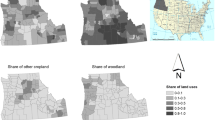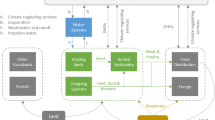Abstract
Classification and mapping of land capability represents an established format for summarising spatial information on land quality and land-use potential. By convention, this information incorporates bioclimatic constraints through the use of a long-term average. However, climate change means that land capability classification should also have a dynamic temporal component. Using an analysis based upon Land Capability for Agriculture in Scotland, it is shown that this dynamism not only involves the long-term average but also shorter term spatiotemporal patterns, particularly through changes in interannual variability. Interannual and interdecadal variations occur both in the likelihood of land being in prime condition (top three capability class divisions) and in class volatility from year to year. These changing patterns are most apparent in relation to the west–east climatic gradient which is mainly a function of precipitation regime and soil moisture. Analysis is also extended into the future using climate results for the 2050s from a weather generator which show a complex interaction between climate interannual variability and different soil types for land quality. In some locations, variability of land capability is more likely to decrease because the variable climatic constraints are relaxed and the dominant constraint becomes intrinsic soil properties. Elsewhere, climatic constraints will continue to be influential. Changing climate variability has important implications for land-use planning and agricultural management because it modifies local risk profiles in combination with the current trend towards agricultural intensification and specialisation.










Similar content being viewed by others
References
Allen RG, Smith M, Perrier LS, Pereira A (1994) An update for the calculation of reference evapotranspiration. ICID Bull 43:35–92
Atkinson MD, Kettlewell PS, Hollins PD, Stephenson DB, Hardwick NV (2005) Summer climate mediates UK wheat quality response to winter North Atlantic Oscillation. Agric For Meteorol 130:27–37
Baier W, Robertson GW (1968) The performance of soil moisture estimates as compared with the direct use of climatological data for estimating crop yields. Agric Meteorol 5:17–31
Barnes A, Toma L (2012) A typology of dairy farmer perceptions towards climate change. Clim Chang 112:507–522
Bibby JS, Douglas HA, Thomasson AJ, Robertson JS (1982) Land capability classification for agriculture. Macaulay Land-use Research Institute, Aberdeen
Brown I (2013) Influence of seasonal weather and climate variability on crop yields in Scotland. Int J Biometeorol 57:605–614
Brown I, Castellazzi M (2014) Scenario analysis for regional decision-making on sustainable multifunctional land uses. Reg Environ Change. doi:10.1007/s10113-013-0579-3
Brown I, Towers W, Rivington M, Black HIJ (2008) Influence of climate change on agricultural land-use potential: adapting and updating the land capability system for Scotland. Clim Res 37:43–57
Brown I, Poggio L, Gimona A, Castellazzi MS (2011) Climate change, drought risk and land capability for agriculture: implications for land-use policy in Scotland. Reg Environ Change 11:503–518
Cantelaube P, Terres JM, Doblas-Reyes FJ (2004) Influence of climate variability on European agriculture—analysis of winter wheat production. Clim Res 27:135–144
Davidson D (1992) The evaluation of land resources. Longman Scientific and Technical, Harlow, 198pp
Davini P, Cagnazzo C (2013) On the misinterpretation of the North Atlantic Oscillation in CMIP5 models. Clim Dyn. doi:10.1007/s00382-013-1970-y%I
Doblas-Reyes FJ, García-Serrano J, Lienert F, Biescas AP, Rodrigues LRL (2013) Seasonal climate predictability and forecasting: status and prospects. WIREs Clim Change 4:245–268
FAO (2007) Land evaluation: towards a revised framework. Land & water discussion 609 paper 6. Food and Agriculture Organization of the United Nations, Rome
Graux A-I, Bellocchi G, Lardy R, Soussana J-F (2013) Ensemble modelling of climate change risks and opportunities for managed grasslands in France. Agric For Meteorol 170:114–131
Hallegatte S (2009) Strategies to adapt to an uncertain climate change. Glob Environ Chang 19:240–247
Handorf D, Dethloff K (2012) How well do state-of-the-art atmosphere–ocean general circulation models reproduce atmospheric teleconnection patterns? Tellus A, 64, 19777. doi:10.3402/tellusa.v64i0.19777
Helland-Hansen B, Nansen F (1920) Temperature variations in the North Atlantic Ocean and in the atmosphere. Smithson Misc Collect 70(4):406
Hudson G, Birnie RV (2000) A method of land evaluation including year to year weather variability. Agric For Meteorol 101:203–216
Hurrell JW, Kushnir Y, Visbeck M, Ottersen G (2003) An overview of the North Atlantic oscillation. In: Hurrell JW, Kushnir Y, Ottersen G, Visbeck M (eds) The North Atlantic Oscillation: climate significance and environmental impact. Geophysical Monograph Series 134. Wiley, New York, p 1–35
Iglesias A, Quiroga S (2007) Measuring the risk of climate variability to cereal production at five sites in Spain. Clim Res 34:47–57
Jones PD, Kilsby CG, Harpham C, Glenis V, Burton A (2009) UK climate projections science report: projections of future daily climate for the UK from the weather generator. University of Newcastle, UK
Keay CA, Jones RJA, Hannam JA, Barrie IA (2014) The implications of a changing climate on agricultural land classification in England and Wales. J Agric Sci 152:23–37
Klingebiel AA, Montgomery PH (1961) Land capability classification. Agricultural Handbook 210. Department of Agriculture, Washington DC
Lin BB (2011) Resilience in agriculture through crop diversification: adaptive management for environmental change. Bioscience 61:183–193
Lin BB, Perfecto I, Vandermeer J (2008) Synergies between agricultural intensification and climate change could create surprising vulnerabilities for crops. Bioscience 58:847–854
Marta AD, Grifoni D, Mancini M, Zipoli G, Orlandini S (2011) The influence of climate on durum wheat quality in Tuscany, Central Italy. Int J Biometeorol 55:87–96
Matthews KB, Rivington M, Buchan K, Miller D, Bellocchi G (2008) Characterising the agro-meteorological implications of climate change scenarios for land management stakeholders. Clim Res 37:59–75
Meinke H, Stone RC (2004) Seasonal and inter-annual climate forecasting: the new tool for increasing preparedness to climate variability and change in agricultural planning and operations. Clim Chang 70:221–253
Mills TC (2004) Is the North Atlantic oscillation a random walk? A comment with further results. Int J Climatol 24:377–383
Nakicenovic N, Alcamo J, Davis G, de Vries B, Fenhann J, Gaffin S, Gregory K, Grubler A et al (2000) Special report on emissions scenarios. Working group III, Intergovernmental Panel on Climate Change (IPCC). Cambridge University Press, Cambridge
Perry M, Hollis D (2005) The generation of monthly gridded datasets for a range of climatic variables over the UK. Int J Climatol 25:1041–1054
Reilly JM (2002) Agriculture: the potential consequences of climate variability and change for the United States. Cambridge University Press, Cambridge
Rossiter DG (1996) A theoretical framework for land evaluation. Geoderma 72:165–190
Schulte RPO, Fealy R, Creamer R, Towers W, Harty T, Jones RJA (2012) A review of the role of excess soil moisture conditions in constraining farm practices under Atlantic conditions. Soil Use Manage 28:580–589
Solhaug KA (1991) Influence of photoperiod and temperature on dry matter production and chlorophyll content in temperate grasses. Nor J Agric Sci 5:365–383
Stephenson DB, Pavan V, Bojariu R (2000) Is the North Atlantic Oscillation a random walk? Int J Climatol 20:1–18
Van Diepen CA, van Keulen H, Wolf J, Berkhout J (1991) Land evaluation: from intuition to quantification. In: Stewart BA (Ed) Advances in soil science, Springer Verlag, New York, p 139–204
Verheye W (2002) Land evaluation systems other than the FAO system. In: Verheye W (ed) Land use, land cover and soil sciences. Encyclopaedia of life support systems (EOLSS). Eolss Publishers, Oxford
Wilby RL, Dawson CW, Barrow EM (2002) SDSM—a decision support tool for the assessment of regional climate change impacts. Environ Modell Softw 1:147–159
World Bank (2006) Sustainable land management: challenges, opportunities, and trade-offs. World Bank, Washington, DC
Wunsch C (1999) The interpretation of short climate records, with comments on the North Atlantic and southern oscillations. Bull Am Meteorol Soc 80:245–255
Acknowledgments
This research was supported by the Scottish Government Strategic Research Programme on Environmental Change. Insightful comments on the practical use of LCA and the manuscript were provided by Willie Towers (James Hutton Institute).
Author information
Authors and Affiliations
Corresponding author
Rights and permissions
About this article
Cite this article
Brown, I., Castellazzi, M. Changes in climate variability with reference to land quality and agriculture in Scotland. Int J Biometeorol 59, 717–732 (2015). https://doi.org/10.1007/s00484-014-0882-9
Received:
Revised:
Accepted:
Published:
Issue Date:
DOI: https://doi.org/10.1007/s00484-014-0882-9




